Most of us spend a good deal of time in our cars, commuting, chauffeuring kids around, doing errands, or if we’re lucky, heading out to an adventure spot. Much of this time is spent being physically uncomfortable, especially if the car was manufactured in the last decade. There seems to be a downward spiral of poor posture and design that reflects poor posture - which in turn worsens posture. How can we break this cycle?
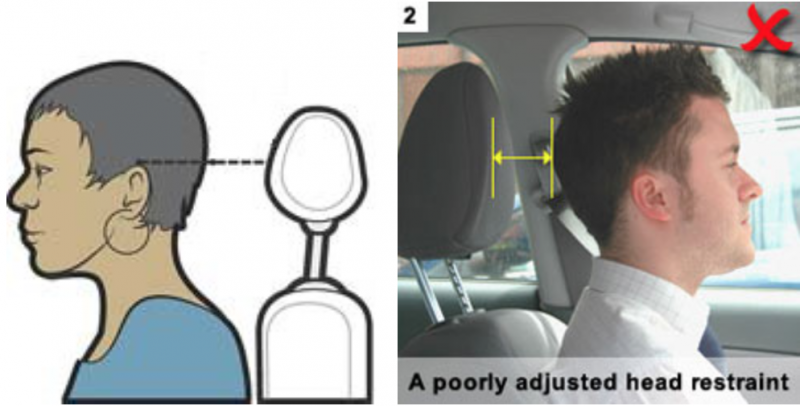
The industry standard for human form reflects the average in society: shoulders forward, S-shaped spine, and forward head. Car seats are designed to fit these features.
A checklist for healthy posture when driving includes:
- Shoulders: back and down
- Neck: elongated and stacked over the spine
- Bottom: well back in the seat
- Spine: elongated and well-stacked
Modern car seats often make these simple posture practices challenging or impossible. The good news is that it’s relatively easy to fix almost any kind of carseat to make it conducive to good posture.
- Shoulder positioning. You may find that the “bolsters” in your carseat get in the way of placing your shoulders back.

The bolsters add considerable horizontal curve to this seat upright, and prevent the arms and shoulders from resting back beside the torso.
The origin of bolsters lies in the racing car industry - bolsters keep racing car drivers in their seats as they whizz around corners at high speeds. For those of us not compelled to turn corners at 100 mph, the bolsters are an annoyance that make it impossible to set the shoulders in a comfortable and healthy place. Solution: Build up the backrest area between the bolsters, so your torso is no longer sunk between the bolsters with your shoulders forced forward. Depending on how much your car’s bolsters protrude, a towel folded over a couple of times may suffice, or you may need a much thicker support. When I travel, I use rental cars. With each rental car, my first action is to profile it: will a single Stretchsit cushion suffice or will it need additional thickness? Technique: After adding some thickness to the mid-portion of the chair upright, move one shoulder at a time a little forward, a little up, and then significantly back and down. Once you have your shoulders back in place, you may discover you need to move your seat closer to the steering wheel to comfortably hold the steering wheel. Be sure to keep a safe distance from the airbag.
- Neck support. Have you noticed that many car headrests push your head forward uncomfortably? The degree seems to get worse with the years. Headrests now have a new official name, which is “head restraint.” They are shaped to stick far enough out that the head is resting against the headrest and would not have any space in which to whip backward in the event of a collision.
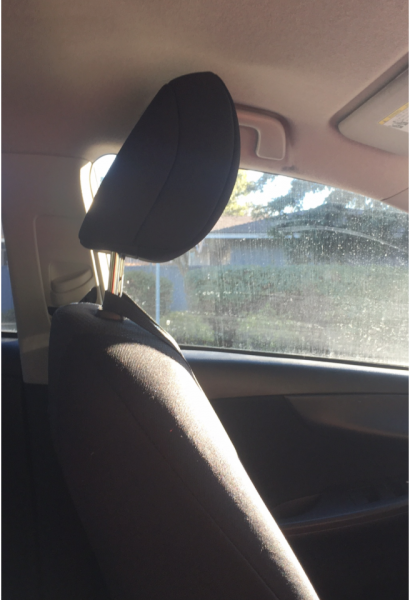
The head restraint, as headrests are now named, reflect, and perpetuate, forward head posture.The standard that determines the extent to which the head restraint juts forward is the Crash Test Dummy. The Crash Test Dummy was modeled on a person with typical Forward Head Posture, and therein lies the rub.
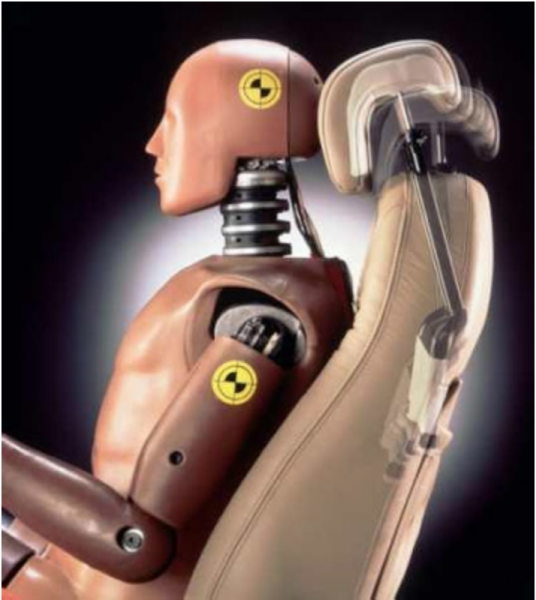
The Crash Test Dummy has forward head postureWhen I taught a workshop to the designers at Johnson Controls in Ann Arbor, they pointed to my Stretchsit cushion and remarked “the reason your products are popular is that we’re legally obliged to design seats the way we do.” It is sad when designers become constrained by deterioration in people's posture.
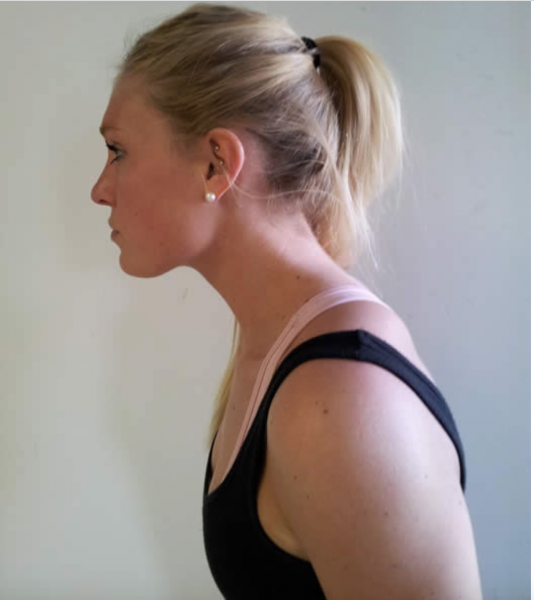
Forward head posture is now so common it negatively influences car headrest design.Solution: Very similar to the solution for bolsters, but the extent of how much you build up the central portion of the backrest now depends on how much the head restraint juts forward. DO NOT turn the headrest around 180 degrees or remove it or sit forward in your seat - in case of an accident, this would put you at risk of severe damage from whiplash. Technique: Determine the best posture you are able to assume in your neck. Now pad the central portion of the backrest so that the headrest works to rest your head against. Elongate your neck in any of the five ways described in 8 Steps to a Pain-Free Back, and “hook” the back of your head against the headrest so your neck is getting a gentle stretch.
- Setting the bottom back in the seat. This is not a problem in most cars. Some notable exceptions are:
- very old cars whose seats have worn down so your bottom sinks into a “cave.”
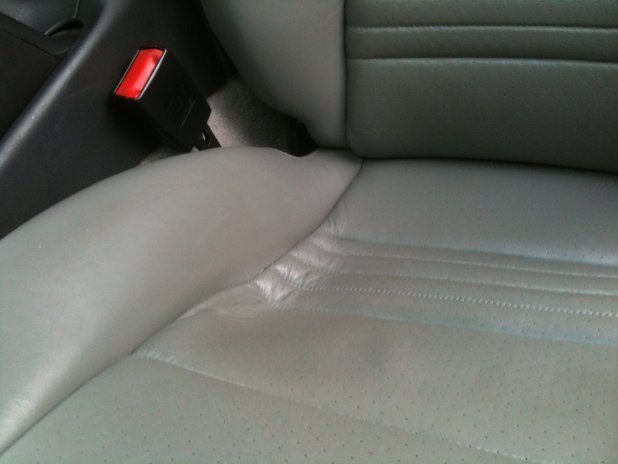
Some carseats wear out in ways that create a "cave" for your bottom to sink into.Solution: build up the cave to horizontal or near horizontal. Do not build it up to be a wedge - wedges are helpful for stacksitting, but not for stretchsitting, and in a car you want to stretchsit, not stacksit.
- Bucket seats: Ouch. Solution: It’s very difficult to fix these. I recommend starting from scratch - go to Relax the Back, buy a seat to place in your bucket seat, and modify as needed.
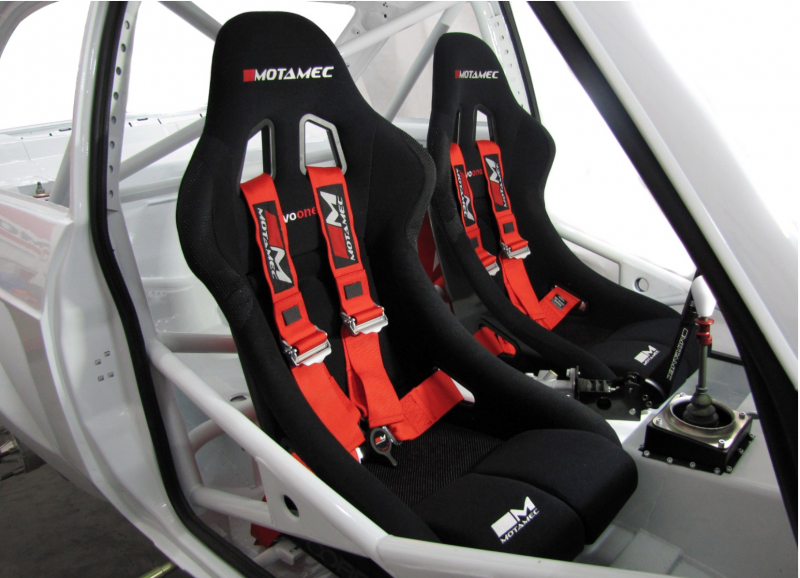
Bucket seats are very difficult to modify so they support healthy posture
- Spine support. Does your car seat have lumbar support? This is based on conventional wisdom about an S-shaped spine being normal and healthy.
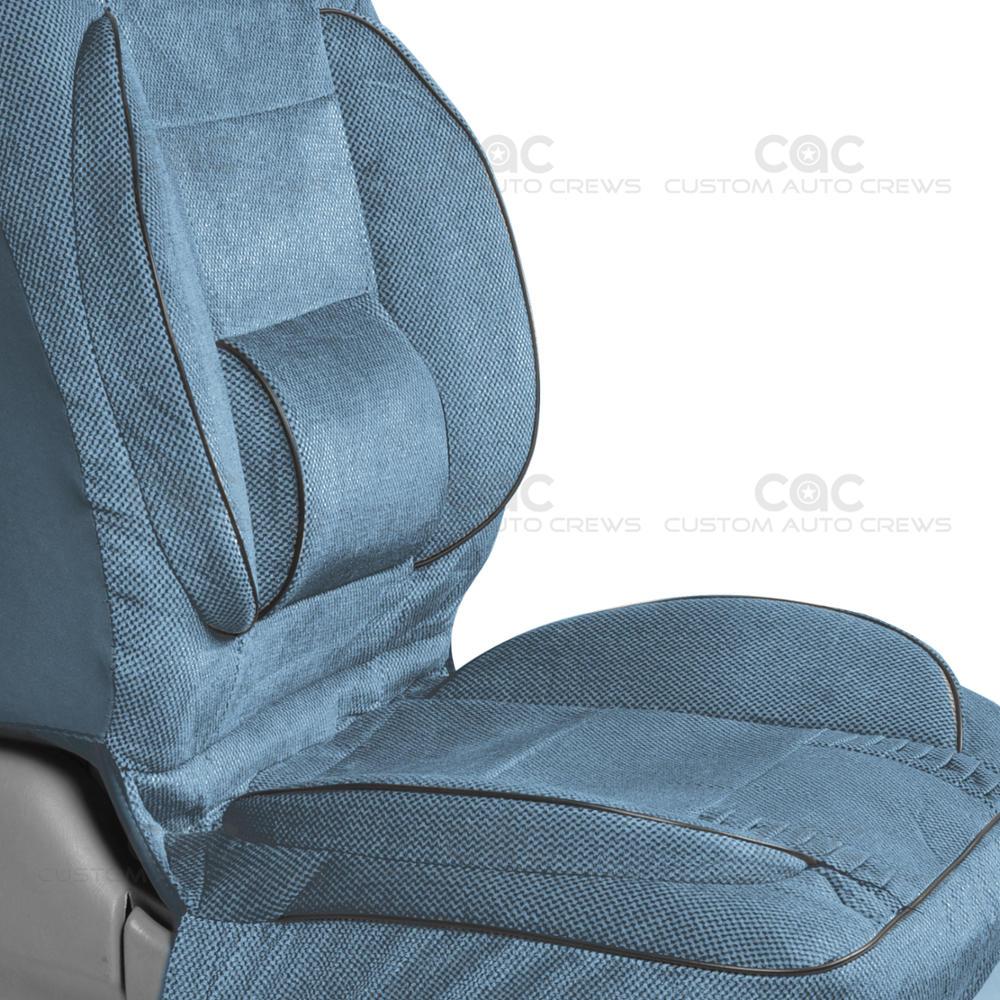
An unhealthy amount of built-in lumbar support in a carseat.My experience is that it causes extra curvature in the spine, tight back muscles, degenerated discs, and arthritic changes in the vertebrae. Solution: What you really need is a thoracic support that you can stretch your back against. Technique: Use a Stretchsit cushion (if you have a fabric seat, a folded towel can also provide the grip you need) suspended behind your mid-back. Follow the instructions in 8 Steps to a Pain-Free Back to stretchsit and put your lower back into a gentle, comfortable amount of traction.
So what can you do to set your car up for healthy posture?
- If you're in the market for buying a car, examine the carseat. Some brands are better than average in the design of their seats. The Fiat 500, for example, has a head rest that works with healthy neck posture, and has bolsters that do not extend all the way up shoulder level.

The Fiat 500 is an example of car model that has a relatively well-designed carseat.
- The Stretchsit cushion is remarkably effective in mitigating a lot of flaws in carseat design. It can neutralize the effects of exaggerated lumbar support, deep bolsters, and head restraints that jut forward too far. In addition, it facilitates stretchsitting, which is healthful in itself, but also dampens the effect of bumps and jolts in driving, especially on bumpy roads.
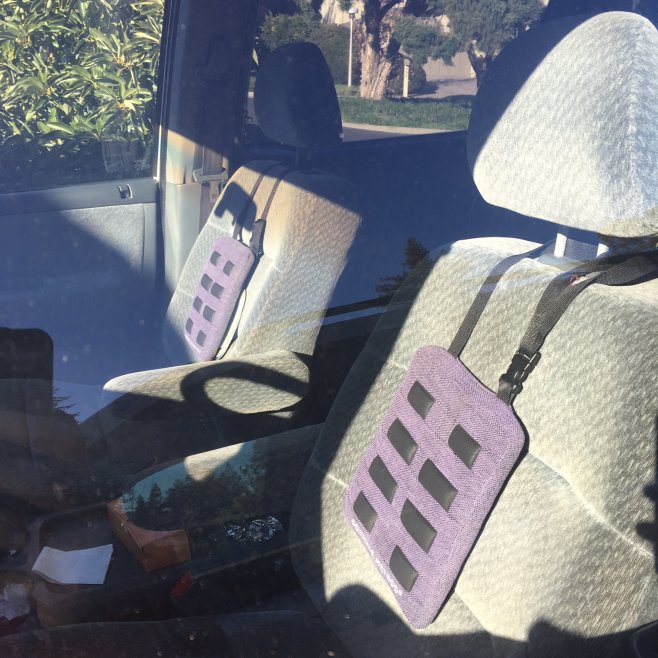
The Stretchsit cushion helps transform poor carseats into healthy carseats.
- Set yourself up with good posture. No matter how good your carseat is, there is no substitute for knowing what to do in your own body. Stretchsitting, which is one of the easiest Gokhale Method techniques, is well suited to driving. Lengthen your spine against a support at the level of your mid-back, roll your shoulders back, elongate your neck against the head rest, and enjoy the ride!
What kind of car do you drive and how well do the seats work to support you? How have you improved your carseat?


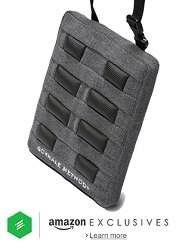


Comments
GREAT article! I've been
GREAT article! I've been using Stretchsit cushions since I took Esther's foundation course in 2009. I've easily adapted the driver's seats in my Chrysler Sebring (2006) and Hyundai Sonata (2007) for comfortable posture-appropriate ride.
Very glad to hear the
Very glad to hear the Stetchsit cushion provided an easy way to be comfortable and healthy!
I have a 1999 Mitsubishi
I have a 1999 Mitsubishi Mirage that is very comfortable and easy to maintain good posture in, and since it's on its last legs I am dreading buying a new car! The first priority is that I can be comfortable in it, so everywhere I go, I peek in people's cars to check out their seats and headrests! Thank you for this article! It may take some extra effort, but at least there are ways I can try and get comfortable when I do get the car!
So glad to hear that you have
So glad to hear that you have articulated that sitting comfortably is an important aspect of car design and that it will influence your purchase!
The head rests on my car made
The head rests on my car made it so painful for me that I had to turn them backwards which I know is not the safest thing to do. I have added the Stetchsit cushion to both vehicles and can comfortable make long trips now.
I'm thrilled to hear that we
I'm thrilled to hear that we helped you be more comfortable AND SAFER!!
If you are in the UK, please
If you are in the UK, please contact your UK Gokhale Method teachers Clare Chapman or John Carter if you would like to purchase a Stretchsit cushion. We will be happy to help.
Brilliant! Now can you tell
Brilliant! Now can you tell us how to modify airplane seats. I am 5'0" and my head is constantly being pushed forward and the width and height of the seat makes me feel like a little girl with my legs either sticking straight out or dangling into space. I even suggested to an airline that they have a "petite" class for us shorties!
Airplane seats tend not to
Airplane seats tend not to fit tallies, shorties, or anyone inbetween! The day we influence plane seats will be a welcome one indeed...I"ve made a few suggestions in this previous blog post, but it's not as easy to modify a plane seat as a carseat, and you're usually stuck in them for much longer. Sorry I don't have a more comprehensive response for flying...one day...
I needed this so much! I
I needed this so much! I honestly thought about buying my next car based on the suitability of the driver's seat. Going to make some modifications tomorrow and see how it goes. Thanks,
That will result in some big
That will result in some big savings for a Happy New Year! Hope it works out!
I don't drive much and I've
I don't drive much and I've been stack sitting with my back away from the back of the seat. I've got the seat as perpendicular as it will go so my back is only an inch or so away from the back cushion. It's a comfortable position for me. I was going to buy a wedge to sit on to make the stack sitting even more "in compliance". Why is stretch sitting better than stack sitting in a car?
Big reason - safety! DO NOT
Big reason - safety! DO NOT risk whiplash in case of an accident - strong deceleration over even an inch can make the difference between severe injury and safety. I very strongly recommend not going this route, especially since there are easy fixes that are safe.
Btw, if you do take to stretchsitting in your car, don't create a wedge. Stretchsitting with a wedge doesn't work well - it tends to result in a sway.
I was very excited to see the
I was very excited to see the article because we recently purchased a Chevy Volt that has just the kind of head rest issue you refer to. I always use your stretch seat cushion but of course, this doesn't help with the neck issues. You refer to padding the area but there are no photos of this. or suggested materials. I am also wondering how one is supposed to get the "padding" to stay. Please provide more details so we can fix the problem.
The padding can be almost
The padding can be almost anything that provides the right amount of thickness. I've used my Patagonia fluffy jacket; I often use a second Stretchsit cushion because when Im traveling to teach I usually have several with me. A second Stretchsit cushion ofers the advantage of staying in place, especially if you use the extension straps to keep it in place, but you can solve this problem in other ways. I commonly help students add thickness with a folded towel or small blanket. This addition will usually stay in place if you have a fabric seat; with leather or vinyl, it's a little trickier. You may need to use a safety pin in a strategic place to keep the towel / blanket from sliding. Sometimes, I teach students to add thickness behind just the upper half of the cushion - this is useful to change the angle of a backrest that slants back too much allowing you to sit more upright. Another thing I often do is to fold the Stretchsit cushion in two along the horizontal midline. That's probably the quickest way of making it thicker, but you have to adjust it each time you get in your car.
Hope this helps! Join me on one of the Free Online Workshops if you are still unsure of how to do this - I'll show you on video.
A nice soft down jacket has
A nice soft down jacket has been my favorite padding for car seats! It can compress so much and doesn't need to be adjusted *just so* to be symmetrical or comfy. I tend to bunch mine into a sort of a wedge, with the thickest part right under the head rest behind my cervical spine, and getting narrower as it pads out behind the thoracic. In some seats I'll bunch it up all the way down through my lumbar spine to create room to put my butt behind me (basically making the outline of the J shape that I want to sit in). You can't truly stretchsit with soft padding like this, but I can stretch my neck against the headrest and still feel some elongation in my spine from the pressure of the padding. If I'm sitting well I can at least engage my inner corset.
I have that same question
I have that same question about padding behind the neck. How in the world does
it seem that it would stay in place?
Sorry I don't have much to
Sorry I don't have much to share here - necessity is the mother of invention!
To get padding to stay in
To get padding to stay in place, I often stick the end of a towel under the headrest and then bring the headrest down on the towel or padding to hold it in place. Directly behidn the neck, you may need to bunch a towel in place once you are already seated, and your neck will hold it there (as long as you don't have to turn around to look out the back window). Imperfect solutions sometimes, but much better than before.
I find the easiest materials to use for padding that don't need so much adjustment are down things, like a jacket or a very small and very soft pillow. This way it compresses just as much as you need to accomodate your posture, but it also expands against you and holds itself in place as you move around a bit while driving.
Some car seats have gaps
Some car seats have gaps between the head rest and the seat, like in the first and third photos ... maybe a towel can be threaded through those types of seats for the padding?
Thanks for this article. I, too, have had problems with car seats being uncomfortable and contributing to poor posture. The forward head restraints are ridiculous, and I think are more forward than they need to be for safety.
Yes, I have used that trick -
Yes, I have used that trick - we have a photo of it in 8 Steps to a Pain-Free Back in Fig 1-18b on page 51.
Agreed the head restraints are crazy, but they do reflect the detriorating average neck position in the population. For safety, you want the neck rest to meet you where you are at - for health, you'ld like that position to be further back and be working toward an improved position if you don't have a good one.
After moving from a 1999
After moving from a 1999 Saturn to a 2014 Honda Accord, I started experiencing right leg and lower back pain. The neck restraint is one issue, and the stretchsit cushion has certainly helped, but there are other issues too. I've noticed that the accelerator pedal is recessed more (also for safety reasons) which I think causes unnatural foot movements toward the brake pedal, causing said pain. Also, should the seat be tilted upward for thigh support, or the opposite? I've almost sold the car, thinking perhaps a higher seated SUV would help.
Judging from the number of
Judging from the number of after-market solutions I discovered online for the Honda Accord 2014 foot pedals, it seems others share your dissatifaction with these! My view is that if you have really mastered stretchisitting as well as external rotation of the leg (this is important), you will be able to navigate the backward slanting seat and pedals. The head restraint looks about average - I rate it as a single Stretchsit cushion headrest.
As far as SUV's go, I had a
As far as SUV's go, I had a 2007 Toyota RAV4 with an electric driver's seat and adjustable lumbar support. The seats were ridiculously uncomfortable, thanks to forward head posture caused by the most extreme headrest. I put in one Stretch-sit cushion and it helped, but that wasn't enough. The best thing I ever did was to get rid of that car! I remember chatting on a RAV4 enthusiasts website and telling people how bad and uncomfortable the headrests were. Some people commented that I WAS THE PROBLEM, not the seat. Others posted links to after-market headrests they purchased to replace the standard one.....a potentially expensive, trial and error process though. The recommendations posted in this article are a great place to start, with Stretch-sit cushions, towels and creativity, along with patience and persistence.
Just curious, what car did
Just curious, what car did you end up finding comfortable?
This 2007 Toyota RAV4 (that
This 2007 Toyota RAV4 (that someone is trying to sell), seems to have two variants of headrests. The one on the left is hugely problematic (unless your head is seriously stuck forward which will take some time to change. Very few people are genuinely stuck in this extreme a position, but they could be if they keep using this kind of headrest!) The one on the right is decent - I suspect it's one of the after-market headrests you referred to.
Glad you are happy with your current car!
I recently bought a 2007
I recently bought a 2007 Acura TSX. A medieval torture rack would be more comfortable than a circa 2007 RAV4, but this Acura is the most comfortable car I have ever owned.
2007 Acura TSX - headrest
2007 Acura TSX - headrest looks decent and bolsters not too deep. A single Stretchsit cushion will do the job on this one...
I have a Ford Fiesta 2013. I
I have a Ford Fiesta 2013. I wouldn't recommend it mechanically but the seat is actually reasonably ok. I used a stretch-sit pillow in my last One but that got stolen with the car so this time I folded up a towel under my shoulder blades (just to add about 1.5 cm) and then loaded the car seat cover over it.
The most comfortable car seat I've been in lately was a VW with adjustable headrests.
The most uncomfortable - Hyundai i20.
I've been aware of your
I've been aware of your cushion for several years, and I'm finally going to break down--before my body breaks down--and buy one. My question is can I use this with the Therm-a-Rest Travel Cushion (https://www.amazon.com/Therm-a-Rest-Travel-Cushion-Nautical-Blue/dp/B00HANW9FY/ref=sr_1_14?ie=UTF8&qid=1484460376&sr=8-14&keywords=Therm-A-Rest) I normally sit on when I sit on an airplane seat?
Thanks in advance for your answer:)
Yes, making your seat pan
Yes, making your seat pan more padded and comfortable is perfectly compatible with stretching your back out against a backrest. Wish you well!
I am a rural carrier and
I am a rural carrier and deliver mail all day long from a vehicle. I bought your cushion and book about a year ago after suffering terrible neck spasms for over a week. I don't know what I would do without them! The cushion really does help me to sit properly. Another carrier had to borrow my vehicle and he wondered about the cushion. He is a big Viking type, and I thought he was going to complain about it, but he said that it really did help him sit up straight!
So happy to hear that the
So happy to hear that the cushion has served you well!
Hello,I've got a Honda Civic
Hello,
I've got a Honda Civic 2014, I live in Romania. After 1 year of driving I can say that my back feels very uncomfortable on long trips. I tried different postures and seat adjustments, but to no avail. What do you reccomend?
The Stretchsit cushion should
The Stretchsit cushion should do the job. If your seats are made of fabric, you can get away with using just a folded towel. We have teachers in Europe (Esther Pohl in Germany and Clare Chapman in the UK) who stock the cushion so you won't have to have it shipped from the US. Good luck!
Especially my lower back. The
Especially my lower back. The car is a 4D LS type
Hi,I have a 2015 Honda CRV EX
Hi,
I have a 2015 Honda CRV EX-L model, Appreciate if you can tell me whether cushion will help. If yes, what would be placement.
thanks
Yes, a single Stretchsit
Yes, a single Stretchsit cushion will be adequate. This model doesn't have extra deep bolsters or a headrest that juts forward overly, so you won't need an extra thickness behind the cushion.
Placement: the nubs want to contact you below the shoulder blades so you can roll your shoulders back without obstruction. Otherwise, it doesn't matter so much exactly where it hits you.
I've struggled to get
I've struggled to get comfortable in my 2002 VW Golf, even with a Stretchsit cushion. It seems like you like some products at "Relax the Back." Is there one in particular that you would recommend for my car?
Thank you!
I greatly value your
I greatly value your attention to the Head Restraint, but this is only one problem for sitting posture in automotive seats. As a retired Professor and researcher who has studied the human body, sitting posture and seat design for over 50 years, it is appalling to read your quotation from Johnson Controls (today Adient) that they are unable to design seats for good sitting posture because they are legally obligated to bad design. The design of the head restraint is covered by NHTSA 202a from the US Department of Transportation but after the last modification to the Regulation, it is no longer a problem to design for sitting posture. The first version of this regulation required use of a 25 degree back angle, a reclined angle used by slumped postures. In the present version, the back angle in design position can be anything that the vehicle manufacturer specifies which includes an upright seat back angle that would move the head restraint rearwards for people to use for comfort and safety. The problem at the seat supplier is not lack of good engineering, it is lack of appropriate tools that represent sitting postures used by drivers of all body sizes. Unfortunately, many in the seat industry think sitting posture is defined by angles in the legs and arms as represented in some of their tools. However, sitting posture is defined by back, leg and arm joint anbles because back joint angles are used for vision and postural comfort.
Seats designs are built initially for the H-point machine, not the crash test dummy you show. The H-point machine was developed in the late 1950s, adopted by SAE in the 1960s and included as a standard in NHTSA Regulations in 1967-8. This tool represents a slumped posture of an average male with legs of a tall male. The tool was based on x-rays of 12 tall men (greater than 80th percentile stature in the late 1950s) sitting in a bench seat to determine the position of the hip joint (thus, the H-point machine). When NHTSA decided to specify head restraint positions to solve the whiplash problem in rear impact crash events, they attached a Head Restraint Measurement Device (HRMD, for short) to the H-point machine. After many months of "government-industry debate", the regulations was released with a required 25 degree back angle. Since almost no one could sit in these seats, this regulation was modified by NHTSA to allow use of seat back angles less than 25 degrees. SAE developed a new tool in the 1990s to replace this 1950s tool, but NHTSA does not allow use of the new tool to satisfy their Rules and Regulations.
The vehicle manufacturer designates H-point position, seat position for the H-point test, and seat adjustments for the Supplier to create seat prototypes. Each iteration of seat design from the Supplier must pass the H-point test as well as meet the backset requirements for the Head Restraint and provide some measure of comfort when people use the seat to drive the new car. This process is over 50 years old and does not use a tool that represents seated postures to design seat shape for safety, comfort and ergonomics.
In the course of developing the shape of these seat prototypes, seat suppliers should carefully design the seat for people of all body sizes to sit in their preferred back postures. To accommodate the range of variation in drivers for safety, comfort and ergonomics, seat back shape at the biteline (intersection of seat back and cushion) and the seat cushion shape at the nose of the cushion have to accommodate a variety of sitting postures. For those people who want to sit in an erect posture which raises eye height, particularly short drivers, there needs to be sufficient space to accommodate moving the buttocks (pelvis) rearward to a position under the torso in the upright, erect sitting posture. In addition, as you correctly point out, an upright posture not only needs support at the lumbar but also at the chest. Many engineers have a difficult time moving the biteline rearward because they feel that support of the buttocks is desireable for slumped postures that people use with a forward head restraint position.
The second area of concern lies in the shape of the front of cushion. When people sit with an upright back posture, they move the seat closer to the accelerator than when they are sit in a slumped posture. This change is due to pelvic rotation and the corresponding change in position of the hip joint. The pelvis rotates over the ischial tuberosities and changes the position of the hip joint in slumped, neutral and erect postures. As a consequence of this change, the angle of the thigh in upright drivers will move downwards which requires a downward seat cushion tilt adjustment. In a slumped posture, the seat cushion tilt is raised to maintain contact with the thigh thereby preventing the feeling that of sitting on a ledge without any thigh support.
I am writing this message because good posture in driving seats is not simply proper spine and back posture. Sitting requires support of body weight but this support changes from load bearing to simple contact that must correctly accommodated. A math-based, patented tool is available for seat design. It is based on digital human body models that represent the deflected shape of soft tissue and the positions of skeletal landmarks for seat design. Johnson Controls had a license for this tool but no longer has the tool. The name of the tool is ERL and I was the Principal Investigator (Herbert M. Reynolds) who led the research to develop this tool, You can read about this tool on Slideshare and the ERL website (www.erlllc.com). I have recently written a chapter for a book on Posturography and Digital Human Models that describes the results of an analysis of 41 vehicles with this tool. This book should be published shortly.
I want to wish you well with your Gokhale Method, and I am available to provide any assistance or answers to any questions you might have.
Herbert, Which cars have the
Herbert,
Which cars have the best seats?
thanks
I have a 2016 Toyota Sienna,
I have a 2016 Toyota Sienna, and chronic low back issues, w/ pain. Basically disc degeneration. It goes from L1-S1. I recentlly started a job that has me driving for up to 3 hrs. daily, and no matter what I try, I can't find a position that doesn't worsen the pain. It's sometimes up to 9/10 in severity and throbbing. I know I need to get to a dr., but I'm very interested in any recommendations you may have.
Wow, the information
Wow, the information Suika game you shared is very interesting, thanks to that I know how to adjust the car seat to the most suitable level.
The author demonstrates a
The author demonstrates a deep understanding of the Among Us Online topic, showcasing expertise and authority through well-researched content.
Here I want to suggest to you
Here I want to suggest to you the game monopoly go. In this game you can play with friends to earn great real estate in the game.